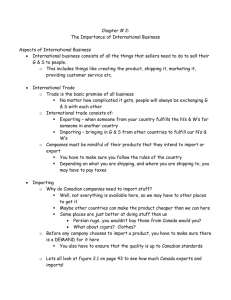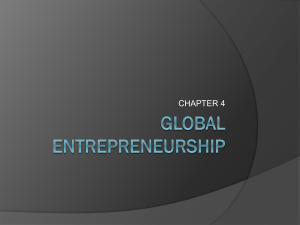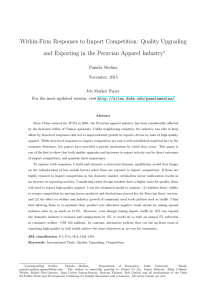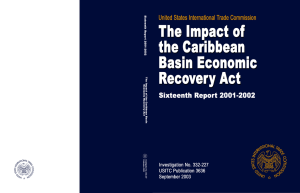Fashion Business in Today's World
advertisement
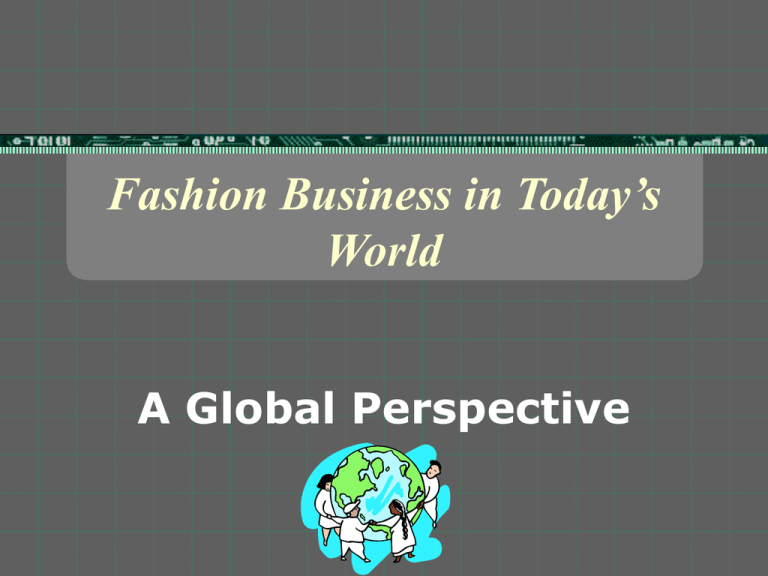
Fashion Business in Today’s World A Global Perspective Objectives: Cite U.S. and world trade trends and policy Explain the relationship of textiles and apparel to developing nations Identify the world’s major trading blocs Describe international sourcing for U.S. fashion importing Point out international market opportunities for U.S. fashion exporting Explain how to discover offshore sources and opportunities Trade Trends and Policy Import penetration: Percentage of imports in a country’s total market consumption U.S. imports 60% of textile and apparel goods Balance of trade: Relationship between values of imports and exports Deficit: imports exceed exports Surplus: exports exceed imports CARGO SHIP Free Trade Goods flow freely in and out of a country without government interference Barriers to free trade: Tariffs (duties) Quotas: limit goods Tariff-rate quotas: certain quantity imported free Voluntary export restraints: applied by exporting country Standards: certain levels of quality Subsidies: producers get government money to lower prices Protectionism Includes many government-imposed trade restraints Most countries have policies between the two extremes Arguments for protectionism: Job protection Strengthen start-up industries Compensation for unequal competition Maintain strong manufacturing base Protect against unsafe or inferior products Reduce trade deficit Dumping The selling of goods at lower prices in a foreign market than in the home market Illegal to dump in U.S. because domestic firms cannot compete Reasons to dump: Create a market niche Drive out competitors Lower inventories Increase profit by increasing production Retain market share during slack periods World Trade Organization International trade accord that reduces tariffs, quotas, and other trade barriers of over 130 countries WTO phasing out in 2005 Eventually all countries are meant to compete with almost free trade New import access to fibers and fabrics Textiles/Apparel and Developing Nations Developing countries start as agricultural societies Textile/apparel industries are often the first to form in emerging economies Structural adjustment refers to industries and economies adapting to shifts in competitiveness A comparative advantage occurs when one nation has the ability to produce a product better than other nations due to specific resources or materials. Trade with Developing Nations Before trading with a developing nation, consider: Political stability Economic climate Their purchasing power Costs of doing business there Infrastructure (roads, power, transportation systems, etc.) Culture World’s Major Trade Regions Asia-Pacific includes: Japan; plus India first to emerge as an export leader Other “Pacific Rim” countries; limited materials but highly industrialized India; main exporter of apparel, but accepts no imports; handicraft work in homes European Union and North Africa European Union (EU) includes 15 developed countries that represent 20% of world’s GDP Free trade exists among European nations; businesses are efficient, competitive, and innovative North African nations do some of the low-wage production for the European nations and the U.S. The Americas North American Free Trade Agreement (NAFTA) has set up a free trade zone among the U.S., Canada, and Mexico Trade barriers for textiles and apparel are being eliminated Mexico’s trade is growing U.S. is looking toward Central and South American markets Item 807/9802 Section of the U.S. Tariff Code that allows manufacturers to export cut garment pieces for assembly elsewhere; import duty paid only on value added Developing areas of the Western Hemisphere have lower production costs thus making it cost effective for contracts with the U.S. International Sourcing for U.S. Importing Low wages make international sourcing desirable for labor-intensive apparel manufacturing Problems with offshore sourcing: Hidden sales, distribution, and management costs Added costs of transportation, insurance, and import fees; delays in receiving Also hard to oversee quality production Larger firms have specific buyers to source internationally Buying from Foreign Sources Import merchants buy and import particular classifications of goods Resident sales agents represent and are paid by foreign manufacturers, connecting them with import buyers Domestically, orders can be written from export merchants at market Export merchants are foreign wholesalers specializing in goods from their home countries Considerations for Foreign Sources Foreign contractors: Manufacturing hired overseas by U.S. apparel producers Licensing agreements: Allows U.S. to produce and market foreign goods Franchising: Retail franchises of foreign firms in U.S. Joint ventures: Agreements that bring skills or products of two firms together Company-owned foreign facilities: U.S. subsidiary operated in a foreign country International Market for U.S. Exporting U.S. consumers represent less than 5% of world market and 25% of buying power Freer trade is opening new markets for U.S. firms Currently, U.S. biggest foreign markets are Japan, Europe, and Canada Closeness to Latin America will open that market Identify Improving U.S. Export Competitiveness overseas markets Make long-term commitments Customize marketing practices for cultural differences Identify market niche Overcome warehousing and transportation problems Offer top service and reliability Improve technology Invest abroad Benefits of Exporting More customers Market diversification Increased profits Extended demand for seasonal products Year-round production Better domestic methods learned Longer product life cycles International Retailing Cross-border retailing: Involves retail company operations serving customers in multiple countries Greater financial risks, but licensing and franchising help reduce risks abroad High financial rewards possible if firms understand cultural attitudes and practices Offshore Sources Key to successful global business is picking the right countries and thinking like the locals Researching international markets is same as any market research Awareness of cultural differences vital to success International trade shows held in U.S. have sections by country; shows also held in various countries Do You Know . . . What are the benefits of free trade? What are the disadvantages? In what ways do cultural differences play a part in exporting? Importing?
![Quiz About [Your Topic]](http://s3.studylib.net/store/data/009237721_1-467865351cf76015d6a722694bb95331-300x300.png)

